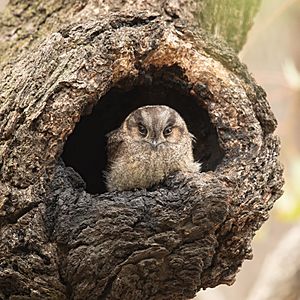Australian owlet-nightjar facts for kids
Quick facts for kids Australian owlet-nightjar |
|
|---|---|
 |
|
| In South Australia | |
| Conservation status | |
| Scientific classification | |
| Genus: |
Aegotheles
|
| Species: |
cristatus
|
 |
|
| Global range Year-Round Range Summer Range Winter Range | |
The Australian owlet-nightjar (Aegotheles cristatus) is a special bird that is active mostly at night. It lives in open woodlands across Australia and in southern New Guinea. People sometimes call it the moth owl because it hunts moths and other insects.
This bird is the most common type of owlet-nightjar. It is also the best-known bird from its secret family. The Australian owlet-nightjar is the most common night bird in Australia. Even though other animals sometimes hunt it, and new species can compete with it, this bird is not considered to be in danger.
Contents
What Does the Owlet-Nightjar Look Like?
The Australian owlet-nightjar is a small to medium-sized bird. Its upper body is grey, and its front is white with stripes. It also has clear dark and light patterns on its head. In northern Australia, female birds can sometimes have reddish-brown feathers. Birds living in the desert usually have lighter feathers overall.
This bird is built to live in open woodlands. It has more pointed wings and larger feet than most other owlet-nightjars. Most of its relatives live in thick forests. However, some Australian owlet-nightjars can also live in dense forests in Queensland and New Guinea. Besides open woodlands, they can live in many other places. These include mangrove swamps, grasslands, mallee scrub, and thick forests.
How Does the Owlet-Nightjar Live?
The Australian owlet-nightjar hunts for food at night. It dives from a branch to catch insects. It can grab insects from the air, the ground, or off tree trunks and branches. It hunts much like a flycatcher. Sometimes, it even catches insects while flying. It eats many kinds of insects, especially beetles, grasshoppers, and ants.
During the day, these birds rest in hollows inside trees. This helps keep them safe from animals that might hunt them. It also stops other birds from bothering them, as other birds might mistake them for owls.
Nesting and Raising Young
The Australian owlet-nightjar usually builds its nest in holes in trees. It can also use other holes or cracks. Both the male and female birds bring leaves to line the nest. They often add eucalyptus leaves. People think these leaves might help keep insects away from the nest.
The female bird usually lays three or four eggs. She sits on the eggs for a little less than a month to keep them warm. Both parents feed the baby birds. The young birds are ready to fly after about a month. It is said that the young birds stay close to their parents for several months after they learn to fly.
Predators
The Australian owlet-nightjar can be hunted by another animal that is active at night. This animal is a large bat called the ghost bat (Macroderma gigas).
See also
 In Spanish: Egotelo australiano para niños
In Spanish: Egotelo australiano para niños



